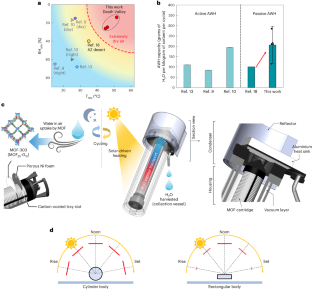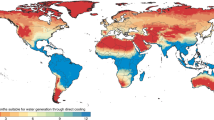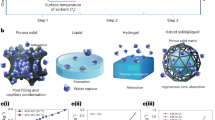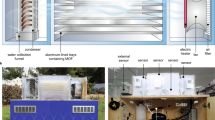Abstract
Sorbent-assisted atmospheric water harvesting has emerged as a promising method to mitigate water stresses in arid climates. Here a new water harvester based on metal–organic frameworks (MOFs) has been designed, constructed and tested in two locations in California (Death Valley National Park and Berkeley). This water harvester is capable of harvesting water at a capacity of 210 and 285 g H2O per kilogram of MOF-303 per day, respectively. The unique configuration of the MOF cartridge and the condenser in the harvester allows the highest efficiency of water uptake and harvesting from air without power or energy input aside from ambient sunlight. Indeed, this water harvester operates passively with double the amount of water harvested compared with our previous passive MOF water harvester. These results highlight the great potential for addressing the water stress problem in the world.
This is a preview of subscription content, access via your institution
Access options
Subscribe to this journal
Receive 12 digital issues and online access to articles
$99.00 per year
only $8.25 per issue
Buy this article
- Purchase on Springer Link
- Instant access to full article PDF
Prices may be subject to local taxes which are calculated during checkout





Similar content being viewed by others
Data availability
The datasets that support this study are available in Zenodo repository with identifier (https://doi.org/10.5281/zenodo.7990951).
References
The Sustainable Development Goals Report (United Nations, 2018).
State of Global Water Resources 2021 (World Meteorological Organization, 2022).
Mekonnen, M. M. & Hoekstra, A. Y. Four billion people facing severe water scarcity. Sci. Adv. 2, e1500323 (2016).
Famiglietti, J. S. The global groundwater crisis. Nat. Clim. Change 4, 945–948 (2014).
Hoekstra, A. Y. & Mekonnen, M. M. The water footprint of humanity. Proc. Natl Acad. Sci. USA 109, 3232–3237 (2012).
Peeters, R., Vanderschaeghe, H., Rongé, J. & Martens, J. A. Energy performance and climate dependency of technologies for fresh water production from atmospheric water vapour. Environ. Sci. Water Res. Technol. 6, 2016–2034 (2020).
Lord, J. et al. Global potential for harvesting drinking water from air using solar energy. Nature 598, 611–617 (2021).
Lu, H. et al. Materials engineering for atmospheric water harvesting: progress and perspectives. Adv. Mater. 34, 2110079 (2022).
Hanikel, N. et al. Rapid cycling and exceptional yield in a metal–organic framework water harvester. ACS Cent. Sci. 5, 1699–1706 (2019).
Almassad, H. A., Abaza, R. I., Siwwan, L., Al-Maythalony, B. & Cordova, K. E. Environmentally adaptive MOF-based device enables continuous self-optimizing atmospheric water harvesting. Nat. Commun. 13, 4873 (2022).
Kim, H. et al. Water harvesting from air with metal–organic frameworks powered by natural sunlight. Science 356, 430–434 (2017).
Deng, F. et al. Hygroscopic porous polymer for sorption-based atmospheric water harvesting. Adv. Sci. 9, 2204724 (2022).
LaPotin, A. et al. Dual-stage atmospheric water harvesting device for scalable solar-driven water production. Joule 5, 166–182 (2021).
Shan, H. et al. Exceptional water production yield enabled by batch-processed portable water harvester in semi-arid climate. Nat. Commun. 13, 5406 (2022).
Song, Y. et al. High-yield solar-driven atmospheric water harvesting of metal–organic-framework-derived nanoporous carbon with fast-diffusion water channels. Nat. Nanotechnol. 17, 857–863 (2022).
Wang, J. et al. Water harvesting from the atmosphere in arid areas with manganese dioxide. Environ. Sci. Technol. Lett. 7, 48–53 (2020).
Guo, Y. et al. Scalable super hygroscopic polymer films for sustainable moisture harvesting in arid environments. Nat. Commun. 13, 2761 (2022).
Fathieh, F. et al. Practical water production from desert air. Sci. Adv. 4, eaat3198 (2018).
Hanikel, N. et al. Evolution of water structures in metal–organic frameworks for improved atmospheric water harvesting. Science 374, 454–459 (2021).
Zheng, Z., Hanikel, N., Lyu, H. & Yaghi, O. M. Broadly tunable atmospheric water harvesting in multivariate metal-organic frameworks. J. Am. Chem. Soc. 144, 22669–22675 (2022).
Kim, H. et al. Adsorption-based atmospheric water harvesting device for arid climates. Nat. Commun. 9, 1191 (2018).
Catalanotti, S. et al. The radiative cooling of selective surfaces. Sol. Energy 17, 83–89 (1975).
Raman, A. P., Anoma, M. A., Zhu, L., Rephaeli, E. & Fan, S. Passive radiative cooling below ambient air temperature under direct sunlight. Nature 515, 540–544 (2014).
Huang, B. L. et al. Thermal conductivity of a metal–organic framework (MOF-5): part II. Measurement. Int. J. Heat Mass Transfer 50, 405–411 (2007).
Erickson, K. J. et al. Thin film thermoelectric metal–organic framework with high Seebeck coefficient and low thermal conductivity. Adv. Mater. 27, 3453–3459 (2015).
Gunatilleke, W. D. C. B. et al. Thermal conductivity of a perovskite-type metal–organic framework crystal. Dalton Trans. 46, 13342–13344 (2017).
Babaei, H. et al. Observation of reduced thermal conductivity in a metal–organic framework due to the presence of adsorbates. Nat. Commun. 11, 4010 (2020).
Goswami, A., Pillai, S. C. & McGranaghan, G. Surface modifications to enhance dropwise condensation. Surf. Interfaces 25, 101143 (2021).
Donati, M. et al. Dropwise condensation: sprayable thin and robust carbon nanofiber composite coating for extreme jumping dropwise condensation performance. Adv. Mater. Interfaces 8, 2170002 (2021).
Cha, H. et al. Dropwise condensation on solid hydrophilic surfaces. Sci. Adv. 6, eaax0746 (2020).
Tanner, D. W., Potter, C. J., Pope, D. & West, D. Heat transfer in dropwise condensation—part I the effects of heat flux, steam velocity and non-condensable gas concentration. Int. J. Heat Mass Transfer 8, 419–426 (1965).
Hntsberger, J. R. Surface energy, wetting and adhesion. J. Adhes. 12, 3–12 (1981).
Zheng, Z. et al. High-yield, green and scalable methods for producing MOF-303 for water harvesting from desert air. Nat. Protoc. 18, 136–156 (2023).
Rao, A. K., Fix, A. J., Yang, Y. C. & Warsinger, D. M. Thermodynamic limits of atmospheric water harvesting. Energy Environ. Sci. 15, 4025–4037 (2022).
Acknowledgements
The authors gratefully acknowledge the permission of conducting research in the private property of The Oasis at Death Valley from 22 to 23 August 2022, located in the Furnace Creek, the Death Valley National Park. Z.Z. thanks A. L. Chaudoin from National Park Service for helpful discussion and suggestions on conducting research near the Death Valley National Park area (36.5319° N, −116.5455° W). The authors thank E. Neumann for his help in collecting SEM images and A. Oddo for his engaging educational discussions. This work was supported by the Joint UAEU–UC Berkeley Laboratories for Materials Innovations, the Fifth Generation (W.S. and O.M.Y.), the Defense Advanced Research Projects Agency (DARPA) under contract HR0011-21-C-0020 (W.S., Z.Z., A.H.A. and O.M.Y.) and KACST-UC Berkeley Center of Excellence for Nanomaterials for Clean Energy Applications.
Author information
Authors and Affiliations
Contributions
W.S. and O.M.Y. conceived and designed the research. W.S. and O.M.Y. led the project and interpreted the results. W.S. designed, constructed and tested the device. W.S. performed energy transfer simulations. W.S. and Z.Z. synthesized and characterized sorbent samples including powder X-ray diffraction, Fourier-transform infra-red spectroscopy and scanning electron microscopy data. W.S., Z.Z. and A.H.A. performed field test at Death Valley and analysed data. W.S. and O.M.Y. wrote the manuscript, and all the authors reviewed it.
Corresponding author
Ethics declarations
Competing interests
O.M.Y. is co-founder of ATOCO Inc., aiming at commercializing related technologies. The remaining authors declare no competing interests.
Peer review
Peer review information
Nature Water thanks the anonymous reviewers for their contribution to the peer review of this work.
Additional information
Publisher’s note Springer Nature remains neutral with regard to jurisdictional claims in published maps and institutional affiliations.
Supplementary information
Supplementary Information
Supplementary methods, Figs. 1–24 and Tables 1 and 2.
Supplementary Video 1
Time-lapse video of AWH in the Death Valley area (20 August 2022).
Supplementary Video 2
Real-time (1× speed) video to show initial water droplets during the AWH test in the Furnace Creek, observed at ~11:30, 23 August 2022.
Supplementary Video 3
Time-lapse video of AWH in the Furnace Creek, the Death Valley (23 August 2022).
Rights and permissions
Springer Nature or its licensor (e.g. a society or other partner) holds exclusive rights to this article under a publishing agreement with the author(s) or other rightsholder(s); author self-archiving of the accepted manuscript version of this article is solely governed by the terms of such publishing agreement and applicable law.
About this article
Cite this article
Song, W., Zheng, Z., Alawadhi, A.H. et al. MOF water harvester produces water from Death Valley desert air in ambient sunlight. Nat Water 1, 626–634 (2023). https://doi.org/10.1038/s44221-023-00103-7
Received:
Accepted:
Published:
Issue Date:
DOI: https://doi.org/10.1038/s44221-023-00103-7
This article is cited by
-
Multifunctional integrated pattern for enhancing fog harvesting water unidirectional transport in a heterogeneous pattern
npj Clean Water (2024)
-
Roll-to-roll fabrication of large-area metal–organic framework-based membranes for high-performance aqueous separations
Nature Water (2024)
-
Fundamentals and applications in water treatment
Nature Water (2024)
-
Sustainable moisture energy
Nature Reviews Materials (2024)
-
Scalable and efficient solar-driven atmospheric water harvesting enabled by bidirectionally aligned and hierarchically structured nanocomposites
Nature Water (2023)



